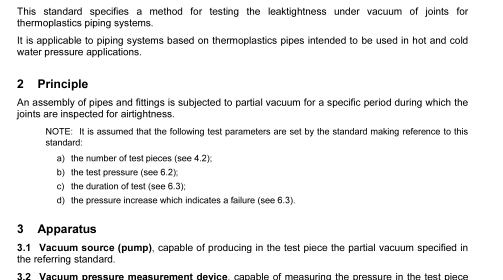BS EN 12294:2000 – Plastics piping systems Ð Systems for hot and cold water Ð Test method for leaktightness under vacuum

1 Scope
This standard speclifies a method for testing the leaktightness under vacuum of joints for thermoplastics piping systems.
It is applcable to plplng systems based on thermoplastics pipes intended to be used in hot and cold water pressure applications.
2 Principle
An assembly of pipes and ftings is subjected to partial vacuum for a speclic period during which the joints are inspected for airtightness.
NOTE: It is assumed that the fllowingn test parameters are set by the standard making reference to this standard:
a) the number of test pleces (8ee 4.2k
b) the test pressure (8e8 6.2x
c) the curation of test (see 6.3);
d) the pressure increase which indicales a lilure (see 6.31.
3 Apparatus
3.1 Vacuum source (pump), capable of producing in the test piece the partial vacuum specifed in the referring standard.
3.2 Vacuum pressure measurement device, apable of measuring the pressure in the test piece with an accuracy of +0,01 bar1).
3.3 Shut-off valve, to isolate the test piece from the vacuum source (3.1).
3.4 Thermometer(s). capable of checking conformity to the specified test temperature (see 6.1).
3.5 End-sealing device, of appropriate size and sealing method, for sealing the nonjointed end of the test plece.’ The device shall be restralined in a manner that does not exert longitudinal forces on the joints.
3.6 A typical test arangement is shown in Figure 1.
4 Test pieces
4.1 Preparation
The test piece shall comprise an assembly of pipes and/or ftings joined in accordance with the manufacturer’s recommended practice.
The test plece shall be connected to the vacuum source (pump) vla a line with a shut-off valve. The vacuum pressure measurement device shall be connected between the shut-off valve and the test plece.
4.2 Number
The number of test pieces shall be as specifed in the rfrring standard.
5 Conditioning
Condition the test piece at (23土5) °C for at least2 h.
6 Procedure
B.1 Ensure that during this procedure the test temperature is maintained in the range (23土5) °C and that variations in the test temperature do not exceed t2 °C.
6.2 Evacuate the test piece to the test pressure specified in the rfering standard. Record the time when the test pressure is achieved and close the shut-off valve.
6.3 Record the increase of pressure, if any, in the test piece until either the test period specifed in he referring standard has elapsed or prior failure of the test piece as indicated be an increase of intemal pressure [see d) of the note to clause 2].
7 Test report
The test report shall include the flolowing information;
a) a reference to this standard and to the refering standard;
b) the ientification and the number of the components under test including their operating pressure;
c) the test temperature;
d) the test duration;
e) the test pressure and, if any. the pressure inrease,
f) any factors which may have afected the results, such as any incidents or any operating details not specifed in this standard;
g) the date of test.
BS EN 12294:2000 – Plastics piping systems Ð Systems for hot and cold water Ð Test method for leaktightness under vacuum